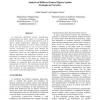Free Online Productivity Tools
i2Speak
i2Symbol
i2OCR
iTex2Img
iWeb2Print
iWeb2Shot
i2Type
iPdf2Split
iPdf2Merge
i2Bopomofo
i2Arabic
i2Style
i2Image
i2PDF
iLatex2Rtf
Sci2ools
80
Voted
IPPS
2007
IEEE
2007
IEEE
Analysis of Different Future Objects Update Strategies in ProActive
In large-scale distributed systems, asynchronous communication and future objects are becoming wide spread mechanisms to tolerate high latencies and to improve global performances. Automatic continuation, that is the propagation of a future object outside the activity that has generated it, can be used to further increase concurrency at system level through the anticipation of tasks. An important aspect of automatic continuation, which can cause different performance in different application and deployment scenarios, is the mechanism for updating result values of future objects, when they are ready. In this paper, we analyze the behaviour of the implementation of different updating strategies, by comparing them with the one currently implemented in ProActive. The experimental results show that the lazy home-based strategy behaves better than other strategies in some application scenarios that are very common in distributed applications.
Automatic Continuation | Distributed And Parallel Computing | Future Objects | IPPS 2007 | Large-scale Distributed Systems |
| Added | 03 Jun 2010 |
| Updated | 03 Jun 2010 |
| Type | Conference |
| Year | 2007 |
| Where | IPPS |
| Authors | Nadia Ranaldo, Eugenio Zimeo |
Comments (0)

